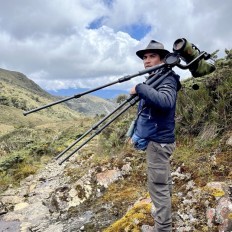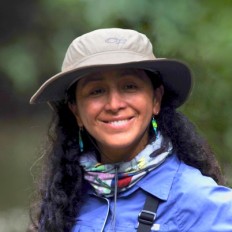While most birds are resident and birding is good throughout the year, the main factor that will make or break your stay is the weather. Located well above 3000 meters above sea level, nights are cold (and often freezing cold), and day time temperatures only rise above 20 degrees celsius if the sun breaks through the clouds. Unchog can be dry and sunny, but (more often) it can be wet, cold and (very) misty. So given the high altitude (which makes walking a bit more tiring), and the potential adverse weather on any day of the year, it is recommended to reserve at least 2 days (and more comfortable, 3) at this site, in order to see the key species.
Most people do daytrips from Huanuco, and until there is a sensible option in terms of sleeping / eating nearby, this is, even with the long transfer time, probably the most sensible/comfortable strategy to bird at Unchog. One can always take food and water and camp at the start of the trail, but nights are very cold. The reward could be Scissor-tailed Nightjar and Andean Snipe.
There are 3 main forest blocks one can bird.The first is to the Left of the trail, up the slope. This block can already hold Golden-backed Mountain-tanager. In between 1st and 2nd, there are some areas for e.g. tapaculos and thistletails. The second forest block is probably the best for Pardusco and Bay-vented Cotinga, while Golden-backed Mountain-tanager regularly shows up here as well. Rufous-browed Hemispingus can be seen with some luck near the stream in mossy undergrowth at -9.726457, -76.168458, and if it doesn't show up, there is a good chance for Chachapoyas Antpitta at the same coordinate.
Once leaving the second forest block, there is a good view on the forest to the Right at -9.724549, -76.167544, e.g. for Yellow-scarfed and Chestnut-bellied Mountain Tanager in the canopy. T
While the third forest block is still a way down, it shouldn't be neglected, as Rufous-browed Hemispingus is regular there.
While most birds are resident and birding is good throughout the year, the main factor that will make or break your stay is the weather. Located well above 3000 meters above sea level, nights are cold (and often freezing cold), and day time temperatures only rise above 20 degrees celsius if the sun breaks through the clouds. Unchog can be dry and sunny, but (more often) it can be wet, cold and (very) misty. So given the high altitude (which makes walking a bit more tiring), and the potential adverse weather on any day of the year, it is recommended to reserve at least 2 days (and more comfortable, 3) at this site, in order to see the key species.
Most people do daytrips from Huanuco, and until there is a sensible option in terms of sleeping / eating nearby, this is, even with the long transfer time, probably the most sensible/comfortable strategy to bird at Unchog. One can always take food and water and camp at the start of the trail, but nights are very cold. The reward could be Scissor-tailed Nightjar and Andean Snipe.Snipe.
There are 3 main forest blocks one can bird.The first is to the Left of the trail, up the slope. This block can already hold Golden-backed Mountain-tanager. In between 1st and 2nd, there are some areas for e.g. tapaculos and thistletails. The second forest block is probably the best for Pardusco and Bay-vented Cotinga, while Golden-backed Mountain-tanager regularly shows up here as well. Rufous-browed Hemispingus can be seen with some luck near the stream in mossy undergrowth at -9.726457, -76.168458, and if it doesn't show up, there is a good chance for Chachapoyas Antpitta at the same coordinate.
Once leaving the second forest block, there is a good view on the forest to the Right at -9.724549, -76.167544, e.g. for Yellow-scarfed and Chestnut-bellied Mountain Tanager in the canopy. T
While the third forest block is still a way down, it shouldn't be neglected, as Rufous-browed Hemispingus is regular there.
While most birds are resident and birding is good throughout the year, the main factor that will make or break your stay is the weather. Located well above 3000 meters above sea level, nights are cold (and often freezing cold), and day time temperatures only rise above 20 degrees celsius if the sun breaks through the clouds. Unchog can be dry and sunny, but (more often) it can be wet, cold and (very) misty. So given the high altitude (which makes walking a bit more tiring), and the potential adverse weather on any day of the year, it is recommended to reserve at least 2 days (and more comfortable, 3) at this site, in order to see the key species. species.
Most people do daytrips from Huanuco, and until there is a sensible option in terms of sleeping / eating nearby, this is, even with the long transfer time, probably the most sensible/comfortable strategy to bird at Unchog. One can always take food and water and camp at the start of the trail, but nights are very cold. The reward could be Scissor-tailed Nightjar and Andean Snipe.
While most birds are resident and birding is good throughout the year, the main factor that will make or break your stay is the weather. Located well above 3000 meters above sea level, nights are cold (and often freezing cold), and day time temperatures only rise above 20 degrees celsius if the sun breaks through the clouds. Unchog can be dry and sunny, but (more often) it can be wet, cold and (very) misty. So given the high altitude (which makes walking a bit more tiring), and the potential adverse weather on any day of the year, it is recommended to reserve at least 2 days (and more comfortable, 3) at this site, in order to see the key species.



